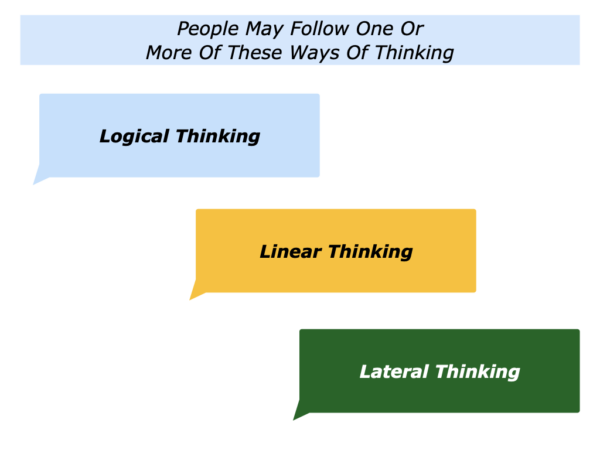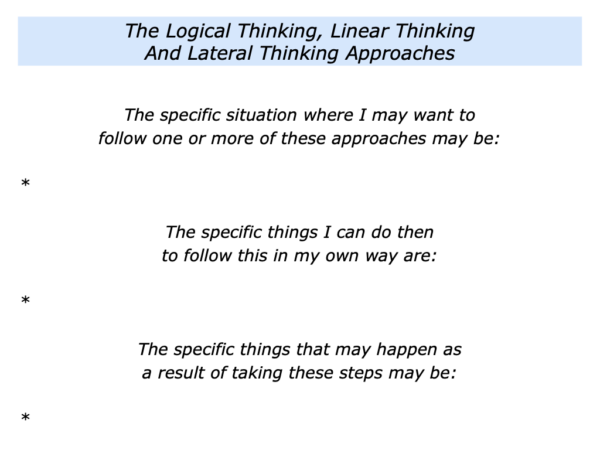
There are many views about how people think in their work. One view is that people may follow one or more of the Logical Thinking, Linear Thinking or Lateral Thinking approaches.
Edward de Bono popularised some of these terms. Since then many people have explored views about whole brain thinking. These include the work of Howard Gardner and Thomas Armstrong on multiple intelligences.
Imagine that you are mentoring a person. How you help them may need to take into account the way that the person thinks. Bearing this in mind, let’s explore these three approaches to thinking.
Logical Thinking
People who follow this approach tend to be logical but also strategic. They may also sometimes follow elements of the lateral and linear thinking approaches.
Such people focus on the real results to achieve in a situation. They then demonstrate both clarity and creativity on the way towards achieving the desired concrete results. They may focus on the following themes.
Clarity
This step involves establishing clarity. It involves exploring some of the following questions when focusing on a situation.
What are the real results to achieve? What will be the benefits of achieving these results? What will be happening that will show we have achieved the picture of success?
Creativity
This step involves clarifying the options going forwards, the strategies most likely to work and any potential creative solutions. It involves exploring some of the following questions.
What are the possible options going forwards? What are the pluses and minuses of each option? Are there any other potential creative solutions? What are the key strategies we can follow to give ourselves the greatest chance of success?
Concrete Results
This step involves settling on the chosen route forwards. It involves exploring some of the following questions.
What is the route – or combination of routes – that we want to follow? How can we build on the pluses and manage any minuses when following this route? How can we translate it into a clear action plan?
Linear Thinking
People who follow this approach also tend be logical but sometimes apply this in a straight-line way. They may follow a systematic step-by-step approach within a specialism or vertical framework.
Such people are often experts in their chosen activity. They are loyal to the craft, diligent and want to deliver high quality. They can play a valuable part in doing fine work.
One approach is to encourage such individuals to be crystal clear on the desired outcomes. This is because sometimes they may prematurely move into implementation mode and listing the tasks to be done.
It is vital to make clear contracts about the outcomes to achieve. They can then follow their systematic approach to delivering these outcomes.
Some people may also see their career path in linear terms. They may have grown up with the idea that, providing they do their job properly, their career progression will happen by pursuing a predictable path. This is not always the case.
Linear thinkers have many strengths and it is vital to use these in the most effective way. They are then more likely to make a superb contribution to an organisation.
Lateral Thinking
People who follow this approach may be seen as innovative. They focus on the results to achieve, gather information and then use their strengths to find creative solutions to challenges.
Such people are sometimes described as ‘thinking outside the box’. But they actually do not see a box. Some use what is called strategic intuition and take the following steps.
They clarify the real results to achieve – the short, medium and long-term pictures of success.
They reach into their experience to recall what has worked in similar situations in the past.
They clarify whether any of these strategies may work in the present situation.
They use their creativity to explore other potential ways forward, set aside time for the ideas to incubate and sometimes make breakthroughs.
They settle on their chosen strategy and clarify how to pursue this to provide the greatest chance of success.
People who are lateral thinkers love designing things and finding creative solutions to challenges. They can play to these strengths and, when appropriate, hand over to implementers who can deliver the goods.
Let’s return to your own work. Looking ahead, can you think of a situation where you may want to follow one or more of the logical, linear and lateral thinking approaches? How can you follow this in your own way?
If you wish, try tackling the exercise on this theme. This invites you to complete the following sentences.



Leave a Reply